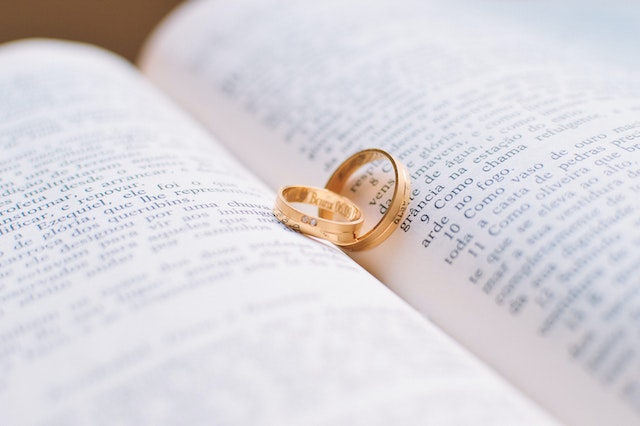
When did people start wearing wedding rings? Wedding rings have been found dating back as far as 4000 BC.
Rings were first used in Egypt by the pharaohs to represent eternity. A ring has no beginning and no end. It also reflects the circular shape of the sun and the moon, both of which the Egyptians worshipped. The open space in the middle of the ring represented a gateway to the unknown.
The first documented evidence of giving a wedding ring can be found in Egypt at this time. Some men gave rings to their wives. The ring was made of hemp, reed, ivory, or leather. When the ring wore out, it could be replaced. The general idea was that the more expensive the material used, the more love there was. The circle represented everlasting love because it had no beginning and end, and the center symbolized the future. The ring was only worn by the wife. The tradition of wearing the ring on the fourth finger of the left hand also comes from this time as well. People thought that the fourth finger contained a vein that ran directly to the heart. It became the left hand because most people are right-handed and there is less chance that the ring will be damaged on the left.
Alexander the Great conquered Egypt and it became part of the Greek Empire. The Greeks took up the idea of wedding rings. Then, the Romans conquered the Greeks and kept the wedding ring idea. They changed it by introducing the first metal bands. They made bands from iron because it is a strong metal and it represented permanence, strength, and an unbreakable bond. The custom spread, but still only women wore the rings, and not a lot of women. Many people weren’t interested in the tradition or couldn’t afford the rings. The Romans also named the vein that they thought went from the heart to the finger. They called it the Vena Amoris, which means the vein of love.
Over the centuries, iron bands were replaced by gold for the people that could afford them. By the 2nd century AD, most rings were gold and people started engraving the rings with messages or images. Signet rings became more popular as well. People started showing off their wealth by giving larger and more extravagant gold rings. Some people even had images of themselves carved into the rings. The Romans also started to add gemstones to the rings. The most common type of ring was a gold ring engraved with two holding hands. The hands symbolized love and marriage. These rings were called fede rings. The word comes from the Latin “mani in fede”, which means “hands clasped in faith”. These rings were popular for over a thousand years.
The tradition of ring giving continued, but it expanded with the growth of Christianity. In 900 AD, Christian wedding ceremonies used wedding rings but they were still only worn by women. The rings were still the lavish and carved fede rings, if people could afford them, but the church frowned on this and insisted that the rings were simple. The simple wedding bands that we wear today were introduced around this time.
In the 16th and 17th centuries, people started to wear rings called gimmel rings. This was a ring that had two interlocking gold bands. The ring could be separated into two pieces and the man and the woman wore one band each until the wedding. In the wedding ceremony, the two pieces were reunited into one ring that the wife wore.
Men only began to wear wedding rings very recently. During World War 1, men who were sent to the frontline began to wear a ring to remind them of their wives back home. After the war, in 1926, the jewelry industry embarked on a huge marketing campaign to encourage men to wear wedding rings as well. They emphasized feminism, equality, and the sanctity of marriage. That campaign, coupled with World War 2, convinced people that both men and women should wear rings when they got married. The tradition of exchanging rings during the ceremony became common from this point on. There are many other “traditions” that the jewelry industry have come up with as well. And this is what I learned today.
Photo by Caio: https://www.pexels.com/photo/two-gold-colored-wedding-bands-on-book-page-56926/
Sources
https://rusticandmain.com/blogs/stories/history-of-wedding-rings
https://4cs.gia.edu/en-us/blog/origin-of-wedding-rings/
https://en.wikipedia.org/wiki/Wedding_ring
https://www.bbc.com/news/magazine-12986535
https://bloedstone.com/blogs/news/history-of-mens-wedding-engagement-rings-their-origin
